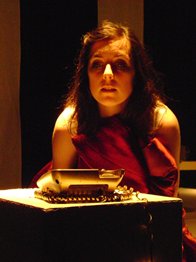Written in 1932 The Human Voice is a monologue play which consists entirely of a woman speaking with her former lover on the telephone. He has left her for another woman and is calling to request that his belongings be returned. The ex is not seen or heard and so, in his absence, the telephone as an object gradually exerts a somewhat insidious presence; however perfunctory the objective behind his call may be, it operates as a lifeline to the distraught, abandoned woman. “I knew you would give me a ring” she says, with deliberate irony.
 To illustrate the telephone’s sustaining power, Theatrecorp’s production offers an unnaturalistic set comprised of cream cloth and several gold telephones displayed on separate plinths, or pedestals. The show signals its stylistic intentions immediately; this symbolic stage picture attests to a broader aesthetic which eschews the straightforwardly naturalistic and is sustained throughout the production. What is being evoked here is a convention pertaining to the general area of surrealism and the poetic image. Actor Ionia Ní Chróinín commences her performance with a movement sequence which involves her encountering and responding to each of the telephones, an outward reflection of her inner, psychical condition which is dominated by the anguish of waiting for that crucial call. This technique of imaging the text is continued throughout the piece by the inclusion of a series of poetic physical reveries.
To illustrate the telephone’s sustaining power, Theatrecorp’s production offers an unnaturalistic set comprised of cream cloth and several gold telephones displayed on separate plinths, or pedestals. The show signals its stylistic intentions immediately; this symbolic stage picture attests to a broader aesthetic which eschews the straightforwardly naturalistic and is sustained throughout the production. What is being evoked here is a convention pertaining to the general area of surrealism and the poetic image. Actor Ionia Ní Chróinín commences her performance with a movement sequence which involves her encountering and responding to each of the telephones, an outward reflection of her inner, psychical condition which is dominated by the anguish of waiting for that crucial call. This technique of imaging the text is continued throughout the piece by the inclusion of a series of poetic physical reveries.
The decision to make a monologue ‘move’ in this manner might, in this case, represent a considered response to at least two issues. First of all, although Jean Cocteau denied being a Surrealist, his work frequently exemplifies the artistic concerns and tropes associated with that movement, in particular its emphasis on dream states and the juxtaposition of unexpected elements. In addition, as is perennially pointed out, Irish theatre is almost synonymous with the monologue play and any director going near one, whether it’s Irish or not, will often endeavour to transform and rejuvenate this format.
While these are persuasive factors, whether The Human Voice benefits from this kind of embodied oneiric treatment is up for debate. There are other, equally salient, factors which warrant exploration. The play charts the mental disintegration of a middle-aged woman, it depicts a bewildering range of fluctuating emotional states and delusional reasoning, and it reflects a time gone by when a woman’s career consisted of living for her man; “I’ve never had anything to live for but you.” This dissolution and effacement, coupled with the thematic importance of voice, seems to indicate the pertinence of something less embodied, less assertive. Consequently, I think there’s another element at work here which has influenced director Max Hafler’s approach. As an alternative to accessing the suffering and gradual debilitation of the abandoned woman, Hafler’s production is determined to discern in her more resilient contours.
It is a decision that I’m not entirely convinced is vouchsafed by the script which, by depicting a moment of torment in real time, would seem to anatomise the particular agony and indignity of severance, rather than operate as a broader meditation upon the processes of letting go. As such, the visually realised attempts at demonstrating resilience struggle to connect with the verbal and emotional landscape of the play, and, as the piece advances, the feeling that there is a fundamental disparity, a gap, at the play’s core persists. The woman’s outward behaviour rings hollow, it’s as if she is merely putting on a brave face. Indeed so persistent is this mode of forced geniality, all wide-eyes and convivial, almost conspiratorial, laughter, that she appears a little unhinged, slightly hysterical; somebody so out of whack with their emotions it’s not altogether surprising her lover fled.
Regrettably, the resonating impact that the surreal movement sequences might otherwise exert on the spectator, both emotionally and within the imagination, somehow fail to take root and develop; I was curiously unmoved by the display. The movements function as charming, rather eccentric, visual vignettes - all beautifully executed by Ni Chróinín it must be noted. Indeed, Ní Chróinín is a good performer, and Hafler is one of the country’s bravest and most imaginative directors. However, The Human Voice should be gut-wrenching stuff; currently it gestures quaintly, like semaphore.